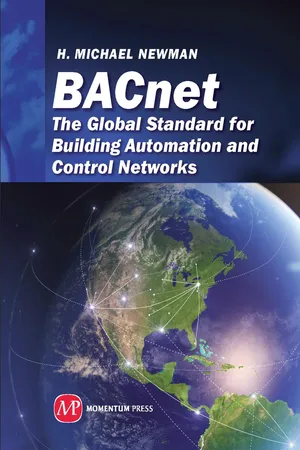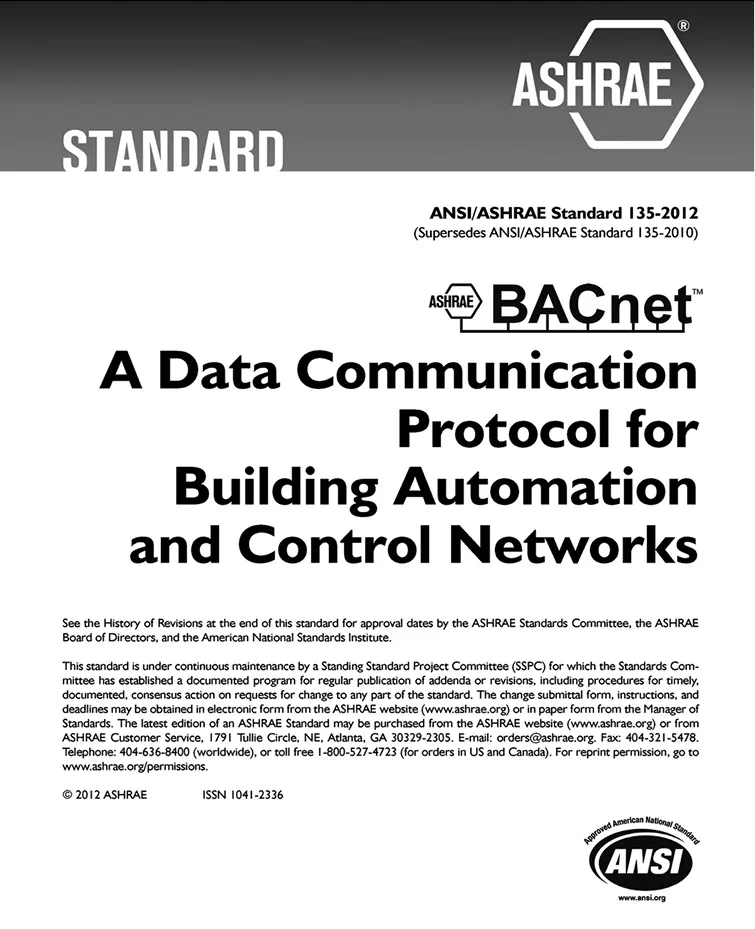![]()
Chapter 1
Introduction
In this chapter we will begin our BACnet journey together. I will present an overview of the technology and answer some of the most basic questions about the standard and its development, use, testing, supporting organizations, and so on. So let’s go!
1.1 What Is BACnet? A Brief Overview
There are several answers to this question. First, “BACnet” is an acronym that stands for “Building Automation and Control networking protocol.” A networking or data communication “protocol” is a set of rules that governs how computers exchange information with one another. In BACnet’s case, these rules have been developed by a Standard Project Committee (SPC 135) within the American Society of Heating, Refrigerating and Air-Conditioning Engineers (ASHRAE) starting back in 1987. ASHRAE’s BACnet set of rules has been approved as an American National Standard by the American National Standards Institute (ANSI) and the latest version is formally known as “ANSI/ASHRAE Standard 135-2012, BACnet—A Data Communication Protocol for Building Automation and Control Networks.” Since the need to continuously enhance and improve the standard was foreseen from the time the very first version of BACnet was published in 1995, ASHRAE formed a “Standing SPC” known as “SSPC 135.” This committee continuously maintains both BACnet and its companion standard, “ANSI/ASHRAE Standard 135.1-2009, Method of Test for Conformance to BACnet.”
BACnet-2012 is now a 1039-page document and is available directly from the ASHRAE Bookstore.
So BACnet is an acronym, a data communication protocol, a set of rules, and a standard. It is also an ASHRAE publication available in hardcopy or as an Adobe Portable Document Format (PDF) file. In this book, where there is a need to compare or contrast the different versions, I will use the expression “BACnet-YYYY” to make the distinction, where “YYYY” is the year of publication. So this book deals primarily with “BACnet-2012.” The first edition was BACnet-1995, etc. Also, when referring to sections of the standard, I will use the terms “Clause” and “Annex.” When referring to sections of this book, I will use the terms “Chapter” and “Appendix.”
A BACnet hat atop the Great Wall of China in 2001.
In addition to being recognized as an ANSI standard, BACnet has been adopted as a national standard by at least 30 other countries including all those of the European Union, Korea, Japan, and Russia. It is also under consideration in some other major countries, including China.
Finally, in 2003, BACnet was adopted as a global standard by the International Organization for Standardization (ISO). In the ISO world, BACnet (135) is known as ISO 16484-5 and the BACnet testing standard (135.1) is ISO 16484-6.
Ordering information for the standards is provided at the BACnet website, www.bacnet .org, along with a cornucopia of other information.
1.2 The BACnet Development Process
Within ASHRAE there are two kinds of standards: those on “periodic maintenance” and those on “continuous maintenance.” The former are subject to reaffirmation, revision, or withdrawal every five years from the time they are first published. The latter, such as BACnet, are continuously maintained. These standards are the responsibility of an SSPC. SSPC 135, or the “BACnet Committee,” currently meets four times a year, at the ASHRAE Winter and Annual Meetings and at two other times, usually hosted by one of the committee member’s companies. Occasionally, other topics are the subject of a special interim meeting beyond the usual four. In the last few years, for example, there have been several “Alarm Summits” to focus entirely on improving the alarm features of the protocol.
1.2.1 Committee Members
SSPC 135 has three officers, a Chair, Vice-Chair, and Secretary. The members are either voting members or non-voting members. A new and special category of non-voting member is the International Organizational Liaison (IOL). The IOL designation allows the committee to formally recognize the contributions of people representing organizations outside the United States and have their names appear on the official committee roster and in the published standard.
1.2.2 Working Groups
In order to address specific topics of importance, the SSPC forms “working groups” (WGs) to consider improvements or additions to the standard. These WGs may come and go as issues arise and are addressed. They may also persist indefinitely. The “Objects & Services WG,” for example, is a combination of two of the WGs formed in 1987! Here is a thumbnail description of the WGs currently in place so that you can get an idea of the range of activities being worked on. For updates, visit www.bacnet.org.
AP-WG: Applications
This group is developing applications-oriented “profiles” to represent various building automation devices such as chillers, variable air volume controllers, and variable frequency drives. The group will focus primarily on the user’s perspective while the Objects & Services Working Group will assist by providing the technical details for the final form of the proposals.
DM-WG: Data Modeling
This group was formed in 2012 to take over and expand the work of the XML-WG, which is now defunct. Its task is to develop framework(s) for complex data models both on the wire and in other machine readable formats. It works in cooperation with the other working groups (e.g., AP-WG and SG-WG) to ensure that the framework(s) developed meet the needs of their specific use cases.
EL-WG: Elevator
The EL-WG is developing extensions to allow the monitoring of elevator and escalator systems with the BACnet protocol.
IP-WG: Internet Protocol
This group has been working on extending BACnet/IP capabilities to deal with developments in the IP world, including Network Address Translation (NAT) firewalls and IPv6.
IT-WG: Information Technology
This group is examining the future communication requirements of building automation systems and considering how they might affect BACnet. An important theme for this group is Information Technology-Building Automation System (IT-BAS) convergence.
LA-WG: Lighting Applications
This group is researching, drafting, and proposing additions to the BACnet standard to support the requirements of lighting control applications. The group is working in cooperation with the National Electrical Manufacturers Association (NEMA) Lighting Control Council and the Illumination Engineering Society Controls Committee.
LSS-WG: Life Safety and Security
This group will research, draft, and propose additions to the BACnet standard to support the requirements of life safety and security applications. The first systems to be tackled were fire alarm and control systems. The group has developed several new objects and services to this end.
MS/TP-WG: Master-Slave/Token-Passing
This group works on enhancements and issues relating to BACnet MS/TP LANs and PTP communications.
NS-WG: Network Security
This group was formed in response to public review comments about managing the primary workstation in life safety emergencies. Their task is to develop a general, network visible mechanism for authorizing and transferring control authority and also to develop auditing mechanisms.
OS-WG: Objects and Services
This group concentrates on “infrastructure” modifications needed to support new objects, new services, or refinements to existing objects and services.
SG-WG: Smart Grid
This group is a continuation of the previous Utility Integration Working Group with a new name. Smart Grid is all about integrating the consumer as an active participant in the operation of the electric grid. This includes integration of facility load as a resource (demand response), customer owned generation (distributed generation), and customer owned storage (electrical, thermal, pumped water, etc.). The SG-WG is focused on enabling the building to act as a full participant in the grid—receiving price and event signals from grid operations as well as requests for resource status—and responding to grid signals with control actions to appropriately manage energy. In addition, this group is working to ensure that BACnet will be able to support the data structures being developed by ASHRAE SPC 201P, the Facility Smart Grid Information Model (FSGIM). The model includes definition of loads, meters, generators, and energy managers that will facilitate developing the ability for BACS to respond to demand response events in an automatic manner, such as altering setpoints, rescheduling equipment operation, etc., in order to lower demand.
TI-WG: Testing and Interoperability
This group’s mandate is to extend and maintain Standard 135.1—the BACnet testing standard, to extend and maintain the BACnet Interoperability Building Block definitions and Device Profiles, and to identify and resolve existing interoperability issues in the BACnet standard itself.
WN-WG: Wireless Networking (inactive)
This group investigated the use of BACnet with wireless communication technologies such as ZigBee, the 802 series of wireless Ethernet, and others. It produced Annex O—BACnet over ZigBee as a Data Link Layer.
XML-WG: XML Applications (work transferred to the new DM-WG)
This group investigated applications of the “eXtensible Markup Language” (XML) technology in relation to BACnet systems.
As you can see, there are enough topics to keep everyone busy for a long time.
1.2.3 Continuous Maintenance
So, how are changes to the standard actually made? Since BACnet is under continuous maintenance (CM), anyone, anywhere, can submit a suggestion for a change at any time. In practice, most change proposals have come from committee members or their colleagues. The proposer writes up his/her proposal with some background information so the committee can understand why the proposal is being made along with recommendations for specific changes. It is then usually doled out to one of the WGs for detailed review. To keep track of the hundreds of proposals that have been made over the years, the SSPC has adopted some proposal naming conventions. Each proposal name starts with the initials of the proposer, a sequence number, and a revision number. The first draft of my third proposal would be of the form “HMN-003-1.” If, after reviewing my proposal, the WG directs me to make some changes, I would submit “HMN-003-2.” Eventually, with any luck, the WG would see the wisdom of adopting my proposal and would pass it on to the full SSPC for a final vote. The next step is to invite the “public” to review it.
Another aspect of the CM process is to issue “interpretations” of the standard. Like change proposals, interpretation requests can be submitted to the SSPC at any time and are in the form of statements about specific wording in the standard followed by the question “Is this interpretation correct?” The SSPC must then rule “Yes” or “No.” Often such requests arise from perceived ambiguities in the standard’s language and lead to clarifications of the standard’s intent.
A final activity is to collect together, from time to time, any errors that have been noticed in the standard and that can be considered typographical or non-substantive, i.e., correcting them has no affect on compliance with the standard. This would include things like misnumbered clause references, misspellings, missing details in a revision history, incorrect indentation levels in a table, etc. These errors are then collected together and published as “errata” every year or so.
1.2.4 Public Review
Once a proposed change has been reviewed and accepted by the full committee, it is usually bundled with other recommended changes and formatted as an “addendum” to the standard. Addenda also have their own naming convention. For example, “Addendum 135-2008g” was an addendum to BACnet-2008 that updated BACnet’s security mechanisms. The suffixes start with the letter “a” (for some reason always in italics) and ...


